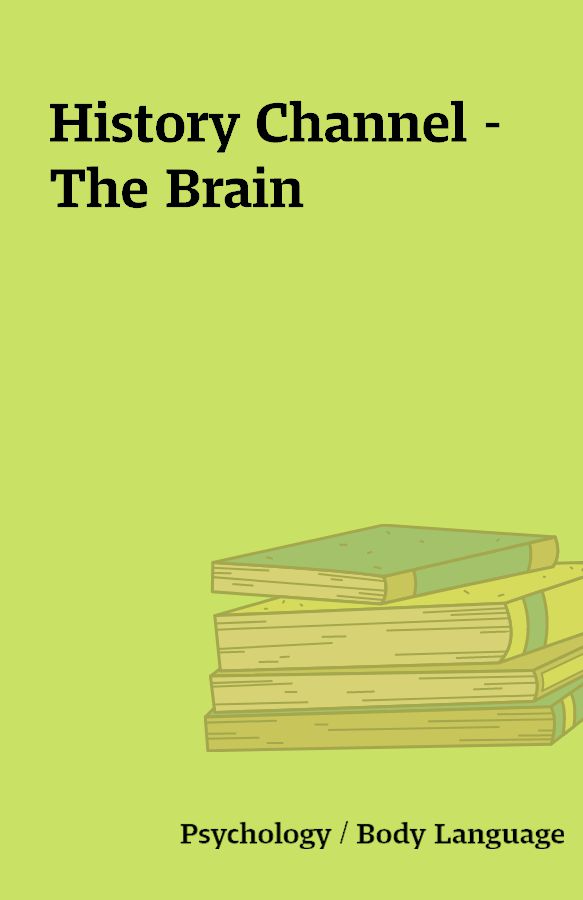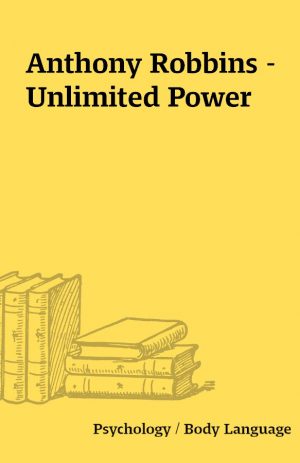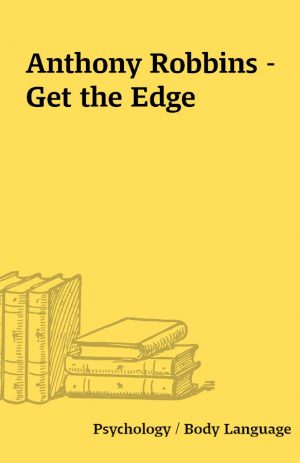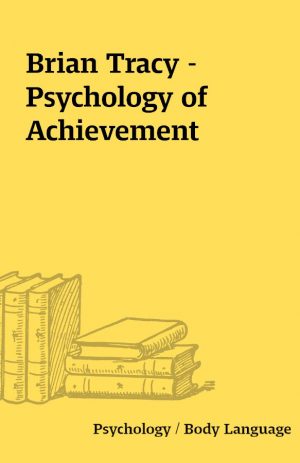History Channel – The Brain
The Brain XviD theplace
[1 Video (AVI)]
Description
For those who want a quick understanding of how the brain works. Relates to subjects talked about in Evolve Your Brain by Joe Dispenza but learn it in 90 minutes. A brief ouline of how the frontal lobe, amygdala and other parts of the brain interact with the rest of the brain during sex, fear, pressure situations, sports and other responses. A must see. Also explains how memory loss and amnesia occurs in a very easy to understand format.link to Evolve Your Brain product SummaryScientists are only now beginning to understand the most complex machine in the known universe – the brain. Go on a voyage of discovery into the evolutionary history of our last biological frontier. From early civilizations’ attempts at neurosurgery to today’s robotic laser surgery, revolutionary new techniques are finally unlocking the story of the brain. As a result, we’ve learned more in the last five years than in the past 100Join the filmmakers at The History Channel as they take an illuminating voyage into the human brain on a mission to better understand the most complex machine in the universe. —————————————————————————————————-ReviewsThis program addressed exactly some of the topics I am studying in Cognitive Neuroscience and the animations and illustrations were much easier to understand than my text! The program really helped me understand the basics so that I could better understand even the most complicated topics of my studies. ———————————————————————————————– State of the art computer graphics help bring simple analogies and real-life case studies to vivid life while revealing the ongoing battle between instinct and reason and exploring the mysteries of memory and decision-making. Venture into the mind of a solder on the battlefield in order to discover how crucial decisions are made under the most extreme circumstances, learn how autistic people accomplish tasks that their normally-functioning counterparts would find impossible to achieve, and discover the answer to the mystery of what makes one person good, and another evil. Scientists have discovered more about the human brain than in the last five years than they did in the entire previous century, and in this documentary those remarkable recent discoveries come into sharp focus. ~ Jason Buchanan, All Movie Guide “The human brain, one of the last great frontiers…We’ve learned more about it in the last 5 years than in the last 5,000 years…For the first time, we’re actually seeing what’s going on in the brain during sex…What makes some brains evil?…And is there really such a thing as ESP [ExtraSensory Perception]?…Technology is finally unlocking the secrets of the brain. It’s explaining why we behave the way we do. It’s helping experts develop new methods and machines to boost our brain power. And its revealing the untapped abilities that we all have inside our heads.” The above is what the narrator states in the introduction of this interesting documentary that uses simple analogies, real-life case studies, and state-of-the-art computer generated images. This program is not about explaining detailed anatomy of the brain. Instead it features experts in brain studies (interweaved with narration) explaining a brain-related topic (like those given above: sex, evil, ESP) and brain function while fantastic animations provide an additional look of what’s going on in the brain (learned through brain-imaging techniques) at a specific time. Eleven brain-related topics are discussed. Eight of the topics last between eight and eleven minutes while three of the topics last between four and six minutes. The last topic is particularly interesting. Discussed is the future of the brain and how technology may interface with the brain to enhance its abilities for all of us. I was amazed at the scope of what this documentary covers. However, each topic is given brief treatment (as can be inferred from the above times). It feels that we are given a sample of each topic. This documentary provides a good starting point if you want to do additional research into a topic. “For all that we have learned about the brain, we still have so much to discover…If we do manage to answer [many] questions [we still have about the brain] over the course of perhaps one more life time, what will this mean for the brain, an organ that is so complicated yet so often driven by primitive instincts?” ———————————————————————————————– Parts of the Brain Discussed (Not All Mentioned, only 90 minutes long!)The HindbrainHaving evolved hundreds of millions of years ago, the Hindbrain or the Reptillian Brain is the oldest part of the human brain. As you might guess from it’s name, it’s a piece of brain anatomy that we share with reptiles and is the most primitive. Likewise it’s in charge of our primal instincts and most basic functions. Things like the instincts of survival, dominance, mating and the basic functions of respiration, heartbeat all come from this area of the brain. Located in the Hindbrain are:The Spinal CordThis is the infomation superhighway of the body. It carries information up to the brain and instructions back down.The Medulla OblongataHelps control the body’s autonomic functions (things you don’t need to think about to perform) like respiration, digestion and heart rate. Also acts as a relay station for nerve signals going to/from the brainThe PonsHas roles in your level of arousal or conciousness and sleep. Relays sensory information to/from the brain. Also involved in controlling autonomic body functions.The CerebellumMostly deals with movement. It regulates and coordinates movement, posture and balance. Also involved in learning movement.The Limbic SystemThe Limbic System sometimes called the “emotional brain” or “Old Mammalian Brain” is the next brain to have evolved in the more primitive mammals about 150 million years ago. This is where our emotions reside, where memory begins and where these two functions combine together to mark behaviours with positive or negative feelings. It’s where mostly unconcious value judgements are made. Information going through the Limbic System are filed under “agreeable or disagreeable”. It also plays a role in salience (what grabs your attention), spontaneity and creativity. Located in the Limbic System are:The AmygdalaIt’s name is latin for almond which relates to its shape. It helps in storing and classifying emotionally charged memories. It plays a large role in producing our emotions, especially fear. It’s been found to trigger responses to strong emotion such as sweaty palms, freezing, increased heart-beat/respiration and stress hormone release.The HippocampusThis guy is all about memory and a little about learning. It’s primary role is in memory formation, classifying information, long-term memory. Like the RAM in your computer it processes and stores new and temporary memory for long term storage. It’s also involved in interpreting incoming nerve signals and spatial relationships.The HypothalamusIt should be called the Hyperthalamus because it does so much. It’s linked closely with the pituitary gland to control many of the body’s functions. It monitors and controls your circadian rhythms (your daily sleep/wake cycle), homeostasis (making sure your body is running smoothly), apetite, thirst, other bodily urges and also plays a role in emotions, autonomic functions and motor functions.The ThalamusThe Thalamus is THE relay station in the brain. Most of the sensory signals, auditory (sound), Visual, Somatosensory (from your skin and internal organs), go through this organ on their way to other parts of the brain for processing. It also plays a function in motor control.The NeocortexThe last and most advanced brain to evolve to date is called the Neocortex, neomammalian or rational brain. We share this part of our brain with other higher level mammals like the primates and dolphins, although in humans the neocortex is the largest. It takes up 2/3’s of the human brain. This is where we find the brain power to develop language, abstract thought, conciousness and imagination. Let there be no doubt, this is what grants us our status on the food chain and allows us to be human.The Neocortex is divided into two hemispheres, right and left. The right side of the brain controls the left side of the body and vice versa. Also the hemispheres are divided in terms of what kind of thought they process or produce. The right being more concerned with the artistic, spatial and musical. While the left is more concerned with the colder, linear, rational and verbal aspects. Located in the Neocortex are:The Frontal LobeThis is the most recent evolutionary addition to the brain. If the brain had a White House it would be here. It is the true center for command and control in your body. The Frontal lobe is responsible for functions such as reasoning, problem solving, judgement, impulse control. This coupled with the fact that it’s the last to develop when we are young adults, probably answers a lot of questions for many parents out there. It also manages our higher emotions such as empathy and altruism. This lobe is also involved in motor control and memory.The Parietal LobeThe Parietal Lobe is involved in processing pain and touch sensation. It’s where the Somatosensory (from your skin and internal organs) Cortex resides. It’s also associated with cognition (including calculating location and speed of objects), movement, orientation, recognition and speech.The Temporal LobeThe Temporal Lobe is involved in auditory (sound) sensation and is where the Primary Auditory Cortex and on the left hemisphere, Wernicke’s Area (language recognition) are located. This lobe is also involved in emotion, memory and speech.The Occipital LobeThe Occipital Lobe controls visual sensation and processing. The Visual Cortex is resides here.Broca’s AreaThis part of the cortex controls speech, language recognition and facial nerves.The Corpus CallosumThis is the neural bridge that connects the two hemispheres to each other, located centrally in brain.
You must be logged in to post a review.






Reviews
There are no reviews yet.